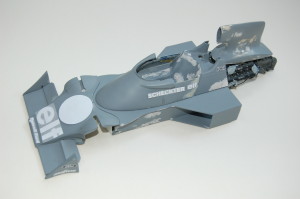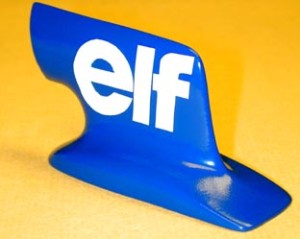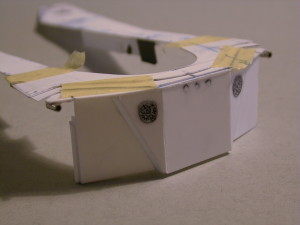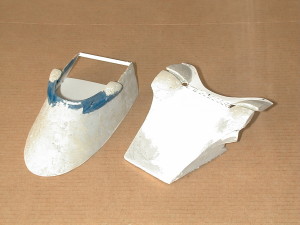Tyrrell 007, 1974
History of the actual car
Tyrrell 007 was Derek Gardner’s next logical design after the 005/6 series, which in its ultimate guise was a highly sensitive design requiring experienced drivers to cope with its twitchy tendencies due too its shorter wheelbase (by 8%). Perhaps aware of this and possibly though confidentially aware of Stewart’s intended retirement at the end of 1973, Derek needed to provide a more predictable design less likely to swap ends in less experienced hands. As it happened (Jackie Stewart having retired and Francois Cevert having tragically died at Watkins Glen in 1973), this was fortuitous as both drivers for 1974 were effectively rookies, South African Jody Scheckter (some experience with McLaren in the M23) and Frenchman Patrick Depailler (drove an 004 twice in 1972).
The new car would be designated the 007, however unlike the previous series, each new car built was numbered 007/1, 007/2 etc, Previously, each new car was numbered according to type rather than chassis number – first built 001 in 1970, a slightly longer 002 was built in 1971 for Cevert, then 003 for JYS also in 1971, 004 became available and later 005, which itself evolved into a hybridised 006 (add-on deformable bodywork as per 1973 regulations). In 1973 a pure 006 from scratch was built, then two others, namely 006/2 and 006/3, the last of these being new and destroyed at Watkins Glen in 1973 whilst Cevert’s prototype 006 was being repaired, Jackie always driving 006/2.
So in moving forward with the 007 series, six would be produced according to chassis number between 1974 and 1976 of which 007/6 (1976 South African GP winner) is retained within Scheckter’s private museum collection to this day. The new P34 six-wheeler was debuted in Spain 1976 by Depailler when new regulations came into force regarding the height of the airbox and a forward roll-over bar within the dashboard area. Scheckter drove 007/6 (sans airbox) at Jarama, 007’s last race.
The 1974 007 monocoque was similar to that of the McLaren M23 with hip mounted water-radiators, however the forward monocoque was quite different to that of McLaren or any previous Tyrrell. New to Tyrrell, torsion bar suspension was incorporated from the start, but was replaced by conventional springing (coil-over-damper) by end of the season, presumably due to the fact that there was no special advantage with torsion bars, also being perhaps less reliable to set-up and live-with than Lotus found between 1970 and 1973. Initial inboard brakes were replaced by outboard brakes by the end of 1974 too, early season failures being the reasoning. The cockpit surround bore resemblance to that of 006 series, a new slim line airbox replacing 006’s very large bulky if not iconic arrangement. The nosecone was quite different, there being a fixed forward element either side of the chisel-nosed version first tested by Stewart on 006/2 in Canada ’73. Large endplates and a rearward adjustable section were fitted each side. This large nose cone had no need of a hot-air exit opening and incorporated a transverse lateral slot in each of two bilateral convex bulges to allow movement of the arched push-rods which activated the torsion bars and later the coil spring/damper units.
Surprisingly, only three Grand Prix wins were achieved, all by Jody and in 1974 there were two wins, one at Anderstorp (where Depailler was second) and the second at Brands Hatch after Niki Lauda’s late race drama with a right rear slow puncture on the Ferrari 312B3. Jody was third at Monza and this put him within a shout of the Championship. The final title showdown at Watkins Glen was between Fittipaldi in a McLaren M23, Clay Regazzoni in a Ferrari 312B3 and Scheckter in Tyrrell 007/2. It wasn’t to be and Jody retired with a fuel pipe breakage from 4th place on lap 44, however he’d have to have won with Emerson unplaced, to be Champion. A conservatively fifth placed Emerson inherited fourth place and was then certain of the Drivers’ title, Regazzoni having retired early in the race with handling issues.
Images
The Model
Following initial production of a 1975 monocoque based on Jody Scheckter’s 1975 car, in 2004/5 I produced a further chassis as per the 1974 car following consultation with Phil Reilly in the US who race prepares such a chassis for an historic racing series there. This would be the same as the earlier modelled 1975 car, except for the rear of the monocoque incorporating wide sidepods ending in line with the central monocoque as per a McLaren M23. This would house transverse water radiators in the same way, unlike the inclined version seen on the later 1975 car. In other ways, this was an identical car to the 1975 monocoque (which I had made previously), the only other difference in the car being the airbox, specific for 1974 along with the simpler roll-over bar.
This airbox, was constructed following detailed study of its side-on (lateral) profile from photographs and dimensional data provided by Phil Reilly in the States. First I made a solid buck out of plastic card and Milliput. Once perfected and sanded and grey primered, it was covered in a thin layer of Sylmasta two-part resin, split sagittally (down the midline) once cured. These formed the basis of a female-mould into which more two-part resin could be pushed to form a thin-walled cast now with a smooth outer surface. Later, the two halves could be combined and the whole hollow structure sanded and filled until a satisfactory hollow lightweight airbox for the 1974 car was ‘finished’. I made two of these, one for my own 1974 model and the other I offered as a birthday present to Jody Scheckter for his birthday in 2005 (following working with the 1979 World Champion repairing and modifying some of his collection of 1/12 scale models between 2000 and 2005).




